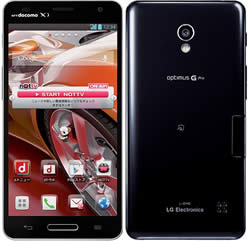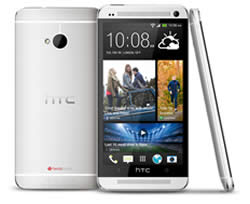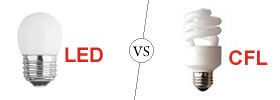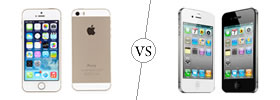Difference between LG Optimus G Pro and HTC One
Key Difference: LG Optimus G Pro has major updates to its predecessor, the LG Optimus G. The device sports a massive 5.5-inch True Full HD IPS touch screen with multi-touch capability and a pixel density of 401 ppi. Under the hood, the phone is powered by 1.7 GHz Quad-core Snapdragon 600, making it pretty fast and speedy. HTC was expected to launch its flagship phone HTC One in March 2013 with a brand new Qualcomm quad-core processor but has postponed the launch to an unknown date in April. HTC One sports a 4.7 inch Super LCD3 screen, with Full HD1080p, 468 PPI and corning gorilla glass 2.
 Since smartphones have become the ‘most important’ device in people’s lives, every smartphone company has been constantly in R&D to try and manufacture new phones with new features to capture the market. LG Electronics is one such company that has been releasing phones in various sizes, trying to boost its product portfolio to draw in customers. LG has been specially giving Samsung direct competition by releasing similar phones within the same time frame. The LG Optimus G Pro is the successor to the original LG Optimus G and resembles the Samsung Galaxy Note II in size and features. The phone has already been announced and launched in Korea, with launch date yet to be released for the rest of the world.
Since smartphones have become the ‘most important’ device in people’s lives, every smartphone company has been constantly in R&D to try and manufacture new phones with new features to capture the market. LG Electronics is one such company that has been releasing phones in various sizes, trying to boost its product portfolio to draw in customers. LG has been specially giving Samsung direct competition by releasing similar phones within the same time frame. The LG Optimus G Pro is the successor to the original LG Optimus G and resembles the Samsung Galaxy Note II in size and features. The phone has already been announced and launched in Korea, with launch date yet to be released for the rest of the world.
The LG Optimus G Pro has major updates to its predecessor, the LG Optimus G. The device sports a massive 5.5-inch True Full HD IPS touch screen with multi-touch capability and a pixel density of 401 ppi. The screen is truly amazing in viewing and the bigger screen is perfect for multi-purpose use (things people usually whip out their tablets or laptops for). The high resolution ensures crisp and sharp images, while the phone has great viewing angles. The large screen also ensures that the device is hard to hold and function with one hand. The G Pro has a sleek plastic chassis, which makes it a slippery when trying to maneuver single-handedly. However, the plastic chassis does not make the phone weak; in fact it is very resilient. LG has made it a bit easier by placing the power and the volume buttons on the right side of the device, rather than placing the power button on the top. Operating the phone requires the person holds the phone in one hand and operates using the other.
Under the hood, the phone is powered by 1.7 GHz Quad-core Snapdragon 600, making it pretty fast and speedy. The device can handle running multiple operations as well as high-res games, without major glitches. The device offers internal memory capacity of 32 GB, which can be expanded further using the microSD slot by 64 GB. The device provides 2 GB worth of RAM, decreasing the lagging effect when running too many apps. The device comes with an NFC, Infrared port, USB and Wi-Fi hotspot capability. The Infrared port ensures that the phone can be made into a remote for any supporting device, while the hot-spot allows the person to share internet with others.
The device houses a 13 MP primary camera for picture taking that supports 4208 x 3120 pixels, and a 2.1 MP secondary camera for video conferencing or calls. The camera is pretty decent in terms of taking hi-res, sharp photos, however, according to The Verge review; the camera has a tendency of washing out colors from the images. The huge viewfinder on the device is great for taking images. Both the cameras have the ability to take videos at 1080p@30fps. One pretty nifty feature on the phone is the Dual-recording feature (similar to the one on the S4), which allows the user to record videos simultaneously from both of the camera. Another feature that is boasted by the company is the Virtual Reality Panorama shot that allows the user to take images and stitch them together for 360 degree panorama shots (this feature is very similar to the Photo Shoot on the Nexus 4).
The device houses a massive Li-Po 3140 mAh battery that is removable, a must feature for many smartphone lovers. The company has yet to release the official data about the Talktime and the Stand-by time offered by the phone. LG has also added the QSlide apps and the QButton feature on the phone. The QSlide apps are widgets that allow the user to do multiple jobs on the same screen, such as take notes, see the calendar, check e-mail and can also allow the user to watch a video and text at the same time. A similar feature is available in the Note II, but it the system only allows the user to access limited apps on the phone. The QButton located on the left side of the device allows the user to access any apps on the phone by pressing the button. The device is yet to hit other shores and prices will also be announced accordingly with the release dates.

HTC was expected to launch its flagship phone HTC One in March 2013 with a brand new Qualcomm quad-core processor but has postponed the launch to an unknown date in April according to Engadget. It is expected to give direct competition to iPhone 5 and Galaxy S4. In terms of hardware and software, HTC One sports a 4.7 inch Super LCD3 screen, with Full HD1080p, 468 PPI and corning gorilla glass 2. The HTC One comes with Android v4.1.2 Jelly Bean that is upgradable to v4.2.2. The case is an all-aluminum frame with an antenna built into its backing. It includes a 1.7 GHz quad-core Snapdragon 600 processor, Adreno 320 GPU and 2 GB DDR2. The phone is available with non-expandable, 32 or 64GB internal capacity. It offers a 4 megapixel 2688 x 1520 pixels primary camera with autofocus, LED flash and BSI sensor, along with a 2.1 MP, 1080p@30fps, HDR secondary camera. The main feature is the new pixilation system that is opted in the primary camera of the phone, which provides each pixel size of 2.0 µm and sensor size of 1/3'.
The One also includes a new camera app known as ‘Zoe’, which records a short video alongside every photo taken and allows the resulting photos and videos to be automatically combined and synchronized with music to produce a multimedia presentation known as a Zoe. The One also offers a new feature on the home screen known as the BlinkFeed. This is a newsfeed that automatically upgrades every two hours if connected with a mobile service or more frequently when connected via WiFi. The BlinkFeed takes up the main home screen and cannot be removed, resulting in the home screen as not being as customizable as in the previous phones. The price of the phone has not yet been released.
The information for the detailed table about the two phones has been taken from theverge.com, engadget.com, HTC website and GSMArena.com.
|
|
LG Optimus G Pro |
HTC One |
|
Launch Date |
Q2/2013 |
Expected release April 2013 |
|
Company |
LG |
HTC Corporation |
|
Size |
150.2 x 76.1 x 9.4 mm |
137.4 x 68.2 x 9.3mm |
|
Display |
5.5 inches True Full HD IPS Plus LCD capacitive touchscreen |
4.7 inch Super LCD3 |
|
Screen |
1080 x 1920 pixels (~401 ppi pixel density) |
1080p, 468 PPI (Full HD) |
|
Protection |
N/A |
Corning Gorilla Glass 2 |
|
Weight |
172 grams |
143g |
|
2G Network |
GSM 850 / 900 / 1800 / 1900 |
HSPA/WCDMA: Europe/Asia: 850/900/1900/2100 MHz |
|
3G Network |
HSDPA 900 / 2100 |
GSM/GPRS/EDGE: 850/900/1800/1900 MHz |
|
4G Network |
Depends on market availability |
Depends on market availability. |
|
GUI |
LG Optimus UI |
HTC Sense 5 |
|
CPU speed |
1.7 GHz Quad-core Snapdragon 600 |
Qualcomm® Snapdragon™ 600, quad-core, 1.7GHz |
|
GPU |
Adreno 320 |
Adreno 320 |
|
OS |
Android v4.1.2 (Jelly Bean) |
Android OS, v4.1.2 (Jelly Bean), upgradable to v4.2.2 (Jelly Bean) |
|
Chipset |
Qualcomm APQ8064T Snapdragon 600 |
Qualcomm APQ8064T Snapdragon 600 |
|
RAM |
2 GB |
2 GB DDR2 |
|
SIM Size |
microSIM |
microSIM |
|
Internal Memory |
32 GB |
32/64 GB |
|
Expandable Memory |
Up to 64 GB |
No |
|
Sensors |
Accelerometer, gyro, proximity, compass |
Gyro sensor, Accelerometer, Proximity sensor, Ambient light sensor. |
|
Connectivity |
2G, 3G, 4G, Wi-Fi, Bluetooth, NFC, Infrared port, DLNA, Wi-Fi hotspot, USB, USB Host. |
Compliant with Bluetooth 4.0, Bluetooth 4.0 with aptX™ enabled, Wi-Fi: IEEE 802.11 a/ac/b/g/n, DLNA, micro-USB 2.0, |
|
Data |
GPRS, EDGE, WLAN, Bluetooth, NFC, Infrared port, USB. |
GPRS, EDGE, WLAN, Bluetooth and USB. |
|
Speed |
HSDPA, HSUPA, LTE |
HSPA+; LTE, Cat3, 50 Mbps UL, 100 Mbps DL |
|
WLAN |
Wi-Fi 802.11 a/b/g/n/ac, dual-band, Wi-Fi Direct, DLNA, Wi-Fi hotspot |
Wi-Fi 802.11 a/ac/b/g/n, Wi-Fi Direct, DLNA, Wi-Fi hotspot |
|
Bluetooth |
Bluetooth v4.0 with A2DP |
Compliant with Bluetooth 4.0, Bluetooth 4.0 with aptX™ enabled |
|
USB |
microUSB v2.0 (MHL), USB Host |
micro-USB 2.0. |
|
Primary Camera |
13 MP, 4208 x 3120 pixels |
4 megapixel 2688 x 1520 pixels, autofocus, LED flash BSI sensor, Pixel size 2.0 µm, Sensor size 1/3', Dedicated HTC ImageChip™ 2 F2.0 aperture and 28 mm lens |
|
Secondary Camera |
2.1 MP, 1080p@30fps |
2.1 MP, 1080p@30fps, HDR |
|
Video |
1080p@30fps Dual-video recording HDR |
1080p@30fps, HDR, stereo sound rec., video stabilization |
|
Camera Features |
|
|
|
Sound Enhancement |
Dolby mobile sound enhancement |
HTC BoomSound, Dual frontal stereo speakers with built-in amplifiers, Beats Audio, HDR Microphone and Sense Voice. |
|
Audio supported formats |
MP3/ WMA/ WAV/ FLAC/ eAAC+/ AC3 player |
Playback: .aac, .amr, .ogg, .m4a, .mid, .mp3, .wav, .wma (Windows Media Audio 9) Recording: .amr |
|
Video supported formats |
MP4/ H.264/ H.263/ WMV/ DviX player |
Playback: .3gp, .3g2, .mp4, .wmv (Windows Media Video 9), .avi (MP4 ASP and MP3) Recording: .mp4 |
|
Battery Capacity |
Removable Li-Po 3140 mAh |
2300 mAh |
|
Talktime |
No official data released |
No official data released |
|
Standby Time |
No official data released |
No official data released |
|
Available Colors |
Black, White |
Gray, White, Black, with more colors to come. |
|
Messaging |
SMS(threaded view), MMS, Email, Push Mail, IM, RSS |
SMS (threaded view), MMS, Email, Push Email |
|
Browser |
HTML5, Adobe Flash |
HTML, Adobe Flash |
|
Radio |
Stereo FM radio with RDS |
Stereo FM radio with RDS |
|
GPS |
GPS with A-GPS support and GLONASS |
A-GPS support |
|
Java |
Java MIDP emulator |
Java MIDP emulator |
|
Additional Features |
|
|
Image Courtesy: engadget.com, anandtech.com









Add new comment